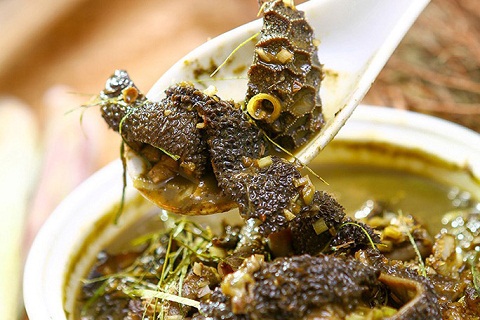
When exploring the highlands of Northwest Vietnam, especially the remote villages of the Thái ethnic people, there’s one dish that both fascinates and frightens visitors — Nậm Pịa. It’s not for the faint of heart, but for the truly adventurous, it’s a culinary experience like no other.
🌿 What Is Nậm Pịa?
In the Thái language, “Nậm” means soup or broth, while “Pịa” refers to the partially digested contents inside the small intestine of grazing animals such as buffalo, cow, or goat. In other words, Nậm Pịa is a digestive-broth dish made from the inner enzyme-rich content of herbivores.
That might sound shocking at first — some even describe it as “a soup made from the essence of the animal’s stomach.” But in the mountain culture, this dish is considered both nutritious and deeply traditional, a food born from the resourcefulness of people living in harmony with nature.
🐃 The Taste That Challenges and Charms
At first glance, Nậm Pịa looks like a thick, murky brown soup. The aroma is strong — earthy, smoky, and herbal, with an unmistakable intensity. The first sip might make you hesitate: it’s bitter, pungent, and slightly sticky.
But then, as the taste settles, something magical happens. The bitterness fades into a rich, savory depth, with the fragrant warmth of mắc khén (the wild pepper of the highlands) dancing on your tongue. Locals describe it poetically:
“The second spoonful is when you truly fall in love — the sweetness of the broth, the richness of the meat, the spice that lingers and sings in your mouth.”
It’s an acquired taste — one that transforms from hesitation to appreciation within just a few bites.
🔥 How Nậm Pịa Is Made
The preparation of Nậm Pịa is as fascinating as the dish itself.
It requires both patience and precision — a balance of flavor, aroma, and texture that only experienced mountain cooks can achieve.
- Collecting the Pịa: The cook carefully extracts the enzyme-rich content (pịa) from the small intestine of a freshly slaughtered buffalo, cow, or goat.
- Sealing the Intestine: Both ends of the intestine are tied tightly to preserve its pure flavor and prevent contamination.
- Preparing the Broth: A large pot of bone stock is simmered for hours with meat, cartilage, and various organs to create a deeply savory base.
- Blending the Flavors: The intestine is cut into pieces and added to the broth, along with wild herbs, lemongrass, garlic, chili, mắc khén, and forest spices.
- Thickening the Soup: After slow cooking, the mixture becomes thick and smooth — a golden-brown or dark amber broth known for its distinctive aroma and complex flavor.
The result is a rustic, hearty, and surprisingly comforting dish that embodies the raw spirit of mountain cuisine.
🍚 How to Enjoy Nậm Pịa
Nậm Pịa is not for everyone. The first taste can be challenging — bitter, rich, and slightly gamey. But locals say the best way to enjoy it is with hot rice or fresh bread, which balances the strong flavor. Pair it with a shot of homemade corn wine or rice wine, and you’ll start to understand why this dish is beloved by the people of the Northwest.
🌄 A Taste of Authentic Mountain Life
Nậm Pịa is more than a dish — it’s a story of survival, tradition, and connection to the land.
It reflects the ingenuity of the Thái people, who learned to use every part of the animal and turn even the most unlikely ingredients into something nourishing and meaningful.
So, if you ever travel to Sapa or the northern highlands, and someone offers you a bowl of Nậm Pịa, don’t refuse.
Take a deep breath, be brave, and take that first spoonful. You may just discover a new appreciation for how extraordinary — and creative — mountain cuisine can be.
📍 Experience the Flavors of the Northwest at Sapa Cuisine
At Sapa Cuisine Restaurant, we proudly introduce visitors to the authentic tastes of the Northern Highlands — from smoked buffalo meat and bamboo rice, to unique traditional dishes like Nậm Pịa.
📍 Address: 11 Hoàng Diệu Street, Sapa Town, Lào Cai, Vietnam
📞 Hotline: +84 0964 267 569
📧 Email: cuisinesapa@gmail.com
🌐 Website: www.SapaCuisine.com
Nậm Pịa – a dish that challenges your senses and rewards your curiosity with the true flavor of the mountains.
